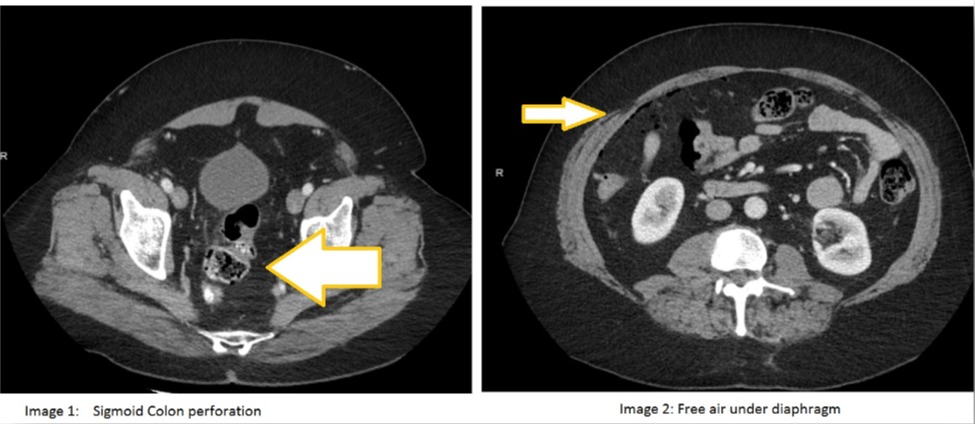Back


Poster Session A - Sunday Afternoon
Category: Colon
A0145 - A Case of Colonic Perforation After CT Colonography
Sunday, October 23, 2022
5:00 PM – 7:00 PM ET
Location: Crown Ballroom

Has Audio
- UG
Ussama Ghumman, MD
Bayhealth Hospital
Dover, DE
Presenting Author(s)
Umair Chishti, MBBS, MD1, Misbah Safdar, MBBS, MD1, Ussama Ghumman, MD1, Arifa Kiran, MBBS2, Sultan Mahmood, MD3, Muhammad Tahir, MD4
1Bayhealth Hospital, Dover, DE; 2Sargodha Medical College, Shorkot, Punjab, Pakistan; 3University of Buffalo, Buffalo, NY; 4University at Buffalo, Buffalo, NY
Introduction: CT colonography is increasingly used in patients with failed initial colonoscopy. Although it is relatively considered a safe procedure but can have serious rare complications with significant morbidity and mortality. We present a case of a patient with failed colonoscopy due to severe diverticular disease who was referred for a CT colonography.
Case Description/Methods: 70 years old male with the history of hypertension, dyslipidemia and recurrent diverticulitis who underwent colonoscopy for diagnostic purposes after recent episode of diverticulitis 3 months ago. Patient last colonoscopy 5 years ago showed extensive diverticular disease and one benign colonic polyp. Colonoscopy was attempted however despite using pediatric colonoscope we were not able to pass the sigmoid colon because of severe angulation and luminal narrowing. After discussion with the patient, decision was made to refer for CT colonography which was performed 2 months later which showed severe sigmoid diverticulosis. Note that the colon was insufflated with carbon dioxide gas.One day after the procedure, patient presented to the outside hospital with worsening abdominal pain and was found to have sigmoid perforation & air under diaphragm (images 1&2). He was taken to the OR urgently and underwent sigmoid resection with creation of colostomy with reversal later. Pathology was negative for malignancy but showed diverticulosis, diverticulitis and serosal adhesions.
Discussion: CRC is the third most common cause of cancer and second leading cause of death from cancer. There are range of screening tests available for CRC screening including stool test, colonoscopy and radiological test including CT colonography. Although CT colonography is relatively a benign procedure but occasionally can cause serious complications. A retrospective analysis by Burling et al. found incidence of colonic perforation 0.08% after analysis of 17067 colonography examinations, while symptomatic perforation rate was 0.03%. (1) The data on colonic perforation after CTC is low (0.005%-0.03%) compared to colonoscopy (0.06%-0.19%) (2). Although CTC is a safe procedure we suggest that prior to referral for this procedure, a detailed risks benefits discussion should be held between the patient and physician.
1.David Burling et al. Potentially serious adverse events at CT colonography in symptomatic patients..
2.Amy Berrington de Gonzalez et al. CT colonography: perforation rates and potential radiation risks

Disclosures:
Umair Chishti, MBBS, MD1, Misbah Safdar, MBBS, MD1, Ussama Ghumman, MD1, Arifa Kiran, MBBS2, Sultan Mahmood, MD3, Muhammad Tahir, MD4. A0145 - A Case of Colonic Perforation After CT Colonography, ACG 2022 Annual Scientific Meeting Abstracts. Charlotte, NC: American College of Gastroenterology.
1Bayhealth Hospital, Dover, DE; 2Sargodha Medical College, Shorkot, Punjab, Pakistan; 3University of Buffalo, Buffalo, NY; 4University at Buffalo, Buffalo, NY
Introduction: CT colonography is increasingly used in patients with failed initial colonoscopy. Although it is relatively considered a safe procedure but can have serious rare complications with significant morbidity and mortality. We present a case of a patient with failed colonoscopy due to severe diverticular disease who was referred for a CT colonography.
Case Description/Methods: 70 years old male with the history of hypertension, dyslipidemia and recurrent diverticulitis who underwent colonoscopy for diagnostic purposes after recent episode of diverticulitis 3 months ago. Patient last colonoscopy 5 years ago showed extensive diverticular disease and one benign colonic polyp. Colonoscopy was attempted however despite using pediatric colonoscope we were not able to pass the sigmoid colon because of severe angulation and luminal narrowing. After discussion with the patient, decision was made to refer for CT colonography which was performed 2 months later which showed severe sigmoid diverticulosis. Note that the colon was insufflated with carbon dioxide gas.One day after the procedure, patient presented to the outside hospital with worsening abdominal pain and was found to have sigmoid perforation & air under diaphragm (images 1&2). He was taken to the OR urgently and underwent sigmoid resection with creation of colostomy with reversal later. Pathology was negative for malignancy but showed diverticulosis, diverticulitis and serosal adhesions.
Discussion: CRC is the third most common cause of cancer and second leading cause of death from cancer. There are range of screening tests available for CRC screening including stool test, colonoscopy and radiological test including CT colonography. Although CT colonography is relatively a benign procedure but occasionally can cause serious complications. A retrospective analysis by Burling et al. found incidence of colonic perforation 0.08% after analysis of 17067 colonography examinations, while symptomatic perforation rate was 0.03%. (1) The data on colonic perforation after CTC is low (0.005%-0.03%) compared to colonoscopy (0.06%-0.19%) (2). Although CTC is a safe procedure we suggest that prior to referral for this procedure, a detailed risks benefits discussion should be held between the patient and physician.
1.David Burling et al. Potentially serious adverse events at CT colonography in symptomatic patients..
2.Amy Berrington de Gonzalez et al. CT colonography: perforation rates and potential radiation risks

Figure: Image 1 and 2
Disclosures:
Umair Chishti indicated no relevant financial relationships.
Misbah Safdar indicated no relevant financial relationships.
Ussama Ghumman indicated no relevant financial relationships.
Arifa Kiran indicated no relevant financial relationships.
Sultan Mahmood indicated no relevant financial relationships.
Muhammad Tahir indicated no relevant financial relationships.
Umair Chishti, MBBS, MD1, Misbah Safdar, MBBS, MD1, Ussama Ghumman, MD1, Arifa Kiran, MBBS2, Sultan Mahmood, MD3, Muhammad Tahir, MD4. A0145 - A Case of Colonic Perforation After CT Colonography, ACG 2022 Annual Scientific Meeting Abstracts. Charlotte, NC: American College of Gastroenterology.
